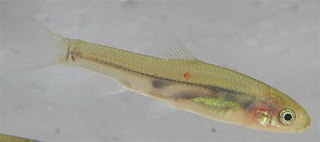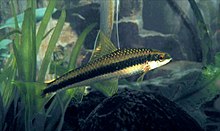
Cyprinidae is a family of freshwater fish commonly called the carp or minnow family, including the carps, the true minnows, and their relatives the barbs and barbels, among others. Cyprinidae is the largest and most diverse fish family, and the largest vertebrate animal family overall, with about 3,000 species; only 1,270 of these remain extant, divided into about 200 valid genera. Cyprinids range from about 12 mm (0.5 in) in size to the 3 m (9.8 ft) giant barb. By genus and species count, the family makes up more than two-thirds of the ostariophysian order Cypriniformes. The family name is derived from the Greek word kyprînos.

Cypriniformes is an order of ray-finned fish, which includes many families and genera of cyprinid fish, such as barbs, gobies, loaches, botias, and minnows. Cypriniformes is an “order-within-an-order”, placed under the superorder Ostariophysi—which is also made up of cyprinid, ostariophysin fishes. The order contains 11-12 families, over 400 genera, and more than 4,250 named species; new species are regularly described, and new genera are recognized frequently. Cyprinids are most diverse in South and Southeast Asia, but are entirely absent from Australia and South America. At 112 years old, the longest-lived cypriniform fish documented is the bigmouth buffalo.

Barbus is a genus of ray-finned fish in the family Cyprinidae. The type species of Barbus is the common barbel, first described as Cyprinus barbus and now named Barbus barbus. Barbus is the namesake genus of the subfamily Barbinae, but given their relationships, that taxon is better included in the Cyprininae at least for the largest part.

Labeo is a genus of carps in the family Cyprinidae. They are found in freshwater habitats in the tropics and subtropics of Africa and Asia.

The Siamese algae-eater is a species of freshwater fish in the carp family, Cyprinidae. This bottom-dwelling tropical fish is found in mainland Southeast Asia, including the Chao Phraya and Mekong basins as well as the Malay Peninsula. Its natural habitats are streams and rivers as well as flooded forests during the rainy season. The Siamese algae-eater should not be confused with the flying fox or the false siamensis , lacking the distinctive black bands of the former.

Garra is a genus of fish in the family Cyprinidae. These fish are one example of the "log suckers", sucker-mouthed barbs and other cyprinids commonly kept in aquaria to keep down algae. The doctor fish of Anatolia and the Middle East belongs in this genus. The majority of the more than 160 species of garras are native to Asia, but about one-fifth of the species are from Africa.
Phillips's garra is a species of freshwater fish in the family Cyprinidae. It is found only in Sri Lanka, where it is restricted to a single stream on the Moussakele tea estate, near Gammaduwa in the Upper Knuckles mountain range at altitudes between 1,036 and 1,066 m ASL.
Tylognathus is an invalid genus of ray-finned fishes in the family Cyprinidae. It was established by Heckel in 1843 without a type species. Varicorhinus diplostomus, described by Heckel in 1838 and erroneously redescribed by the same author in 1844 as T. valenciennesii, was later designated the type species. Today this fish is placed in the genus Bangana.

Epalzeorhynchos is a small ray-finned fish genus of the family Cyprinidae. Its members are – like some other cyprinids – known as "freshwater sharks" or simply "sharks". They are, however, freshwater members of the Osteichthyes lineage which is distinct from the Chondrichthyes lineage of sharks. The description of these animals as "shark" is most likely a reference to the shark-like shape of these popular cyprinids.

Labeo bottegi is fish in genus Labeo. It is known from Ethiopia, Kenya, and Somalia.

Labeo dussumieri is fish in genus Labeo known to occur in west-flowing rivers of the Western Ghats. Earlier Sri Lankan population was considered as the same species as L. dussumieri, recent phylogenetic and physiological differences suggest that Sri Lankan population is a distinct species, Labeo heladiva..
Labeo macmahoni is fish in genus Labeo from the drainage of the River Dasht in Pakistan. This species reaches a length of 25 cm (9.8 in).
Garra arupi is a species of cyprinid fish in the genus Garra from the upper Brahmaputra basin in Arunachal Pradesh.
Garra ethelwynnae is a species of ray-finned fish in the genus Garra which is known only from Eritrea. The specific name of this fish honours the British ichthyologist Ethelwynn Trewavas (1900-1993).
Garra geba is a species of cyprinid fish in the genus Garra. It is endemic to Ethiopia.
Garra micropulvinus is a species of cyprinid fish in the subfamily Labeoninae. It is endemic to the upper Red River drainage in Yunnan, China. It grows to 13 cm (5.1 in) standard length.
Garra smartae, the Hasik Garra, is a species of cyprinid fish in the genus Garra from Oman. The specific name honours Emma Smart for her studies of the fish faunas of the wadis of the Arabian Peninsula. The original specific name smarti was amended to smartae to reflect the correct gender of the person being honoured.

Linichthys laticeps is a species of cyprinid fish endemic to China where it is found the in upper and middle Zhu Jiang basin and the upper Chang Jiang basin in the city of Guiyang, Guizhou Province. It is the only member of its genus. This species reaches a length of 11.0 cm (4.3 in).
Prolixicheilus longisulcus is a species of fish in the family Cyprinidae, found in streams belonging to the Zuojiang River, a tributary of Pearl River in China. This species is the only member of its genus.

Crossocheilus langei, also known as the red algae eater, is a species of ray-finned fish in the genus Crossocheilus. It is native to Malaysia and Sumatra. This bottom-dwelling tropical fish is found in mainland Southeast Asia. Its natural habitats are streams and rivers as well as flooded forests during the rainy season. It is often confused with the Crossocheilus oblongus, however, both are algae eaters and will behave similarly.











